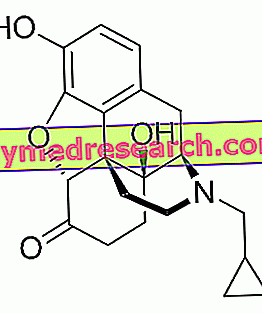Generality
Naltrexone is an opioid receptor antagonist drug.
Its chemical structure is similar to that of naloxone but - compared to the latter - it has a longer duration of action.

Naltrexone - Chemical Structure
Naltrexone is available in pharmaceutical formulations suitable for oral administration and is used in the opioid and alcohol cessation program.
Examples of medicinal specialties containing Naltrexone
- Antaxone ®
- Mysimba ® (in association with bupropion).
- Nalorex ®
- Narcoral ®
Indications
For what it uses
The use of naltrexone is indicated for the maintenance of opioid cessation in already detoxified patients.
Furthermore, naltrexone is used in the treatment of alcohol dependence to lower the risk of relapses and promote alcohol withdrawal.
Warnings
Treatment with naltrexone should only be started and continued under the strict supervision of a specialist in the treatment of opioid or alcohol cessation.
Since the drug is metabolized by the liver and excreted mostly in the urine, the use of naltrexone in patients with liver and / or kidney disease must be done with great caution. In fact, regular checks of liver function must be performed, both before and during treatment with the drug.
Naltrexone can cause withdrawal symptoms in patients with opioid dependence, in fact the use of the drug is indicated for the maintenance of the cessation only in patients already detoxified. In any case, before starting treatment with naltrexone it is advisable to carry out tests to see if patients have recently taken opioids.
In addition, patients should be advised that attempts to counteract the effect of naltrexone with high-dose opioid administration can cause potentially fatal respiratory depression and circulatory depression.
If there are emergencies in which it is necessary to administer opioid analgesics to patients already on naltrexone therapy, the dose of these drugs that must be administered may be higher than the dosages normally used. All this could cause one
deeper respiratory depression and other side effects. In these cases, therefore, patients must be carefully monitored to identify in a timely manner the onset of any dangerous adverse reactions.
Naltrexone may reduce alertness and the ability to drive and / or operate machinery, therefore, great care should be taken.
Interactions
Generally, the concomitant intake of naltrexone and opioid drugs is not recommended.
In addition, great caution should be used in the concomitant administration of naltrexone and the following drugs:
- Barbiturates ;
- Benzodiazepines ;
- Anxiolytics ;
- Hypnotic sedatives ;
- Antidepressants ;
- Antipsychotics ;
- Some types of antihistamine drugs.
If co-administered, naltrexone may cause an increase in acamprosate plasma levels (a drug used to treat alcohol dependence).
However, it is always a good idea to inform your doctor if you are taking - or have recently been - any type of medication, including over-the-counter medicines and herbal and homeopathic products.
Side effects
Naltrexone can cause several side effects, although not all patients experience them.
Listed below are the main side effects that may occur during drug therapy.
Gastrointestinal disorders
Treatment with naltrexone may cause nausea and / or vomiting, abdominal pain, diarrhea or constipation, flatulence, haemorrhoids or ulcer.
Nervous system disorders
Naltrexone therapy can promote the onset of:
- Headache;
- Drowsiness;
- Dizziness;
- Tremors.
Psychiatric disorders
Treatment with naltrexone may cause:
- Nervousness;
- Restlessness;
- Anxiety;
- Irritability;
- Insomnia;
- Hallucinations;
- Confusion;
- Paranoia;
- Depression;
- Nightmares;
- Decreased libido;
- Suicidal ideation and suicide attempts.
Cardiovascular disorders
During therapy with naltrexone, the following may occur:
- Hot flashes;
- Tachycardia;
- Sudden changes in blood pressure;
- Palpitations.
Hepatobiliary disorders
Treatment with naltrexone may favor the onset of disorders, such as:
- Increased blood levels of bilirubin;
- Increased blood levels of transaminases;
- Hepatitis.
Lung and respiratory tract disorders
Naltrexone therapy can cause:
- Chest pain;
- Congestion or nasal discomfort;
- runny nose;
- Oropharyngeal pain;
- Increase in sputum;
- Sinusitis;
- Cough;
- Dyspnoea;
- Dysphonia.
Skin and subcutaneous tissue disorders
Treatment with naltrexone can cause skin rash, acne, seborrhea, itching and alopecia.
Other side effects
Other side effects that may occur during naltrexone therapy are:
- lymphadenopathy;
- Idiopathic thrombocytopenic purpura;
- Blurred vision, increased tearing, eye irritation, eye pain, photophobia or ocular edema;
- Dry mouth;
- Arthralgia and myalgia;
- Rhabdomyolysis;
- Erectile dysfunction or delayed ejaculation;
- Pollakiuria or dysuria;
- Ear pain and tinnitus;
- Cold sores;
- Tinea pedis;
- Reduction or increase in appetite;
- Loss or weight gain;
- Chills;
- Hyperhidrosis;
- Temperature.
Overdose
If an overdose of naltrexone is suspected, it is necessary to immediately inform the doctor who will start all the necessary support therapies.
Action mechanism
Naltrexone is used in maintenance therapy for opioid cessation due to its antagonistic action against opioid μ receptors. Naltrexone is able to selectively bind to these receptors and has a very long duration of action.
The permanence of the naltrexone-receptor μ bond prevents the relapse in drug addiction since - in case of possible opioid administration - it does not allow the latter to interact with the aforementioned receptor; therefore, it prevents these substances from inducing the feeling of gratification that drives individuals to make improper use and abuse it.
Mode of Use - Posology
Naltrexone is available for oral administration in the form of hard capsules, coated tablets or oral solution.
Usually, before starting treatment with the drug, a provocation test is performed by keeping the patient under observation and by administering a small dose of naltrexone by oral, intravenous or subcutaneous route. Furthermore, appropriate urine tests are also performed to ensure that the patient has not recently taken opioids.
If after the provocation test there are no withdrawal symptoms and if the urine tests are negative, then you can proceed with the start of therapy.
Treatment with naltrexone should be started using small doses of medication.
The dose of naltrexone usually recommended is 50 mg of drug per day, to be taken every day; or 100 mg of naltrexone can be administered every other day. Another possibility is to administer the drug three times a week according to this scheme: 100 mg taken on Monday, 100 mg taken on Wednesday and 150 mg taken on Friday.
In any case, the amount of drug to be administered and the frequency of administration will be established by the doctor on an individual basis for each patient. Therefore, it is necessary to strictly follow the indications provided by the latter.
Pregnancy and breastfeeding
Since there are insufficient data to establish the safe use of naltrexone in pregnant women, its use in this category of patients is generally not recommended. Except for the case in which the doctor does not consider it absolutely essential.
Since it is not known whether naltrexone is excreted in breast milk, its use by breastfeeding mothers is contraindicated.
Contraindications
The use of naltrexone is contraindicated in the following cases:
- In patients with known hypersensitivity to naltrexone;
- In patients receiving opioid painkillers for pain treatment;
- In patients already on methadone therapy;
- In patients with opioid dependence or withdrawal symptoms;
- In patients whose urine tests indicate that opioids have been taken;
- In patients with acute hepatitis or liver failure;
- In patients suffering from severe renal insufficiency;
- In children and adolescents under 18 years of age.
Finally, the use of naltrexone is generally contraindicated during pregnancy and lactation.



